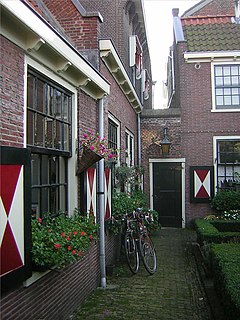
The Bruiningshofje is a hofje in Haarlem, Netherlands.

The Bruiningshofje is a hofje in Haarlem, Netherlands.
It was founded in 1610 by Jan Bruininck Gerritz (it i s assumed), and is one of four hofjes owned by the Mennonite church of Haarlem. The others are the Wijnbergshofje in the Barrevoetestraat, the Zuiderhofje on the Zuiderstraat, and the Blokshofje on the Klein Heiligland (sold in 1970). The founder was from Sneek, and he probably founded the hofje with his daughters in mind, since he had several of them and family members were given first rights to a place in the hofje. The earliest documents surviving date from after this original donor died. A document survives from 1647 in which a sum of 150 Carolus guldens is recorded for adding a new house and garden, received from Lysbeth van Blenckvliet. [1] This early donor was also the founder of the Zuiderhofje, and explains why the garden is managed by the Zuiderhofje gardener.
We know something about the living conditions in this hofje from the list of women who came to live there, compared to the list of deaths, though only the more prominent names are recorded. These women tended to live longer than the general population. The list of donations in the form of preuves. [2] [3] is also quite long; many opted to give a small amount (5 cents) to the women on their death-day. In 1800 this had grown to free rent for all six women, and during the year the following goods for the hofje: 20 5-cent pieces each week, 20 tons turf, two 20-pound barrels of butter, two sacks of potatoes, and a half-sack of salt.
The hofje originally had rooms for six women with a common privy in the garden. It wasn't renovated for running water or gas heat until 1936, when a redesign was executed, resulting in five homes. It was again renovated in 1978, and the number of houses was reduced again from five to four. The hofje was once one of the wealthiest of Haarlem, and is still quite well off today. The rent is free for the four women living there; they only need to pay service costs.
Address: Botermarkt 9

The Frans Hals Museum is a museum located in Haarlem, the Netherlands.

The Hofje van Bakenes or Bakenesserkamer is a hofje in Haarlem, Netherlands, located between the Bakenessergracht and the Wijde Appelaarsteeg. In the Middle Ages "kamer" or "room" meant house. Usually the houses within a hofje consisted of just one room.
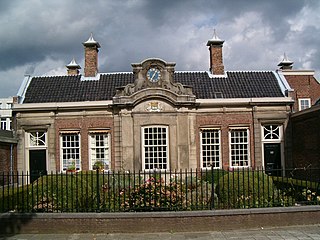
The Hofje van Noblet is a hofje in Haarlem, Netherlands.

The Frans Loenenhofje is a hofje in Haarlem, Netherlands, on the Witte Heren straat.
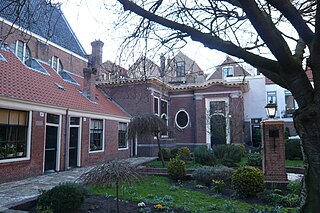
The Lutherse Hofje is a hofje in Haarlem, Netherlands.

The Hofje van Staats is a hofje in Haarlem, Netherlands, on the Jansweg 39, close to the Haarlem railway station.

The Hofje van Loo is a hofje on the Barrevoetstraat 7 in Haarlem, Netherlands.
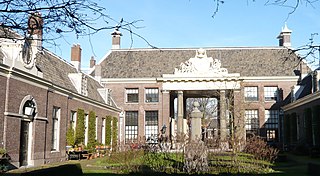
The Teylershofje is a hofje in Haarlem, Netherlands with 24 houses.

Haarlem is one of the cities in the Netherlands that has a number of hofjes. Some of them are still in use with boards of regents. Many of these are members of the Stichting Haarlemse Hofjes. The word 'hofje' just means small garden, because the hofjes are generally small houses grouped around a community kitchen garden with a water pump. Often they were attached to a larger field for bleaching linen or growing orchards, but today those fields have been long used for city expansion and only the central gardens can still be seen.
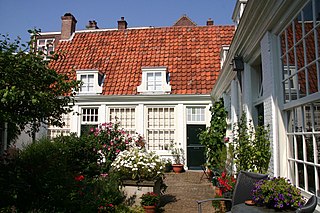
Hofje van Guurtje de Waal is a hofje in Haarlem, Netherlands.
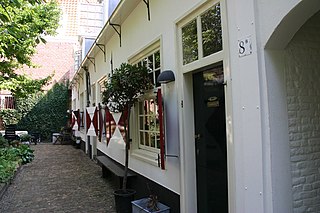
The Brouwershofje is a hofje on the Tuchthuisstraat in Haarlem, Netherlands.

The Hofje van Willem Heythuijsen is a hofje in Haarlem, Netherlands. It was founded in 1650 by the testament of Willem van Heythuysen on the site of his summer residence outside the city walls of Haarlem on land that was considered Heemstede property until it was annexed in 1927. It is one of the few hofjes of Haarlem to be built outside the city walls. It has a 'T' shape and has a small open courtyard and a garden still intact.

The Wijnbergshofje is a hofje in Haarlem, Netherlands, on the Barrevoetstraat.

The Zuiderhofje is a hofje in Haarlem, Netherlands.

The Vrouwe- en Antonie Gasthuis is a hofje on the Klein Heiligland 64a in Haarlem, Netherlands. It is open on weekdays from 10-17.00.

The Proveniershuis is a hofje and former schutterij on the Grote Houtstraat in Haarlem, Netherlands.
The Hofje van Codde en Beresteyn is a hofje in Haarlem, Netherlands. The current building is from 1968 and is located on the J. Cuyperstraat, which is named for the architect who designed the Cathedral of Saint Bavo next door, Joseph Cuypers. This hofje is the wealthiest hofje foundation in Haarlem with the most modern facilities for its inhabitants. Poor (devote) Catholic women of Haarlem 60 years and older are still welcome to live there for free.

The St. Elisabeth Gasthuis (EG) is a former hospital complex of buildings founded in 1581 in Haarlem on the Gasthuisvest. The last location of the hospital on the Boerhaavelaan retains its hospital function and is part of the Spaarne Gasthuis (SG) today, formerly known as Kennemer Gasthuis (KG). The hospital complex on the Gasthuisvest was built for the "Minnebroers" monastery and was reclaimed after the Protestant reformation in 1581 and given by the city council to the hospital. As a hospital during four centuries, the complex underwent many major renovations. The main facade dates from 1871.

The Coomanshof is a former hofje in Haarlem, Netherlands, on the Witte Heren straat.

Joseph Coymans, was a Dutch businessman in Haarlem, known best today for his portrait painted by Frans Hals, and its pendant, Portrait of Dorothea Berck. The former resides at the Wadsworth Atheneum in Hartford, the latter at the Baltimore Museum of Art. A portrait of the couple's son Willem is held by the National Gallery of Art in Washington, D.C.